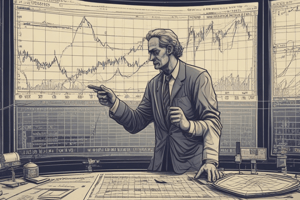Podcast
Questions and Answers
How long do short-term trends typically last?
How long do short-term trends typically last?
- 3 to 6 weeks (correct)
- Less than 3 weeks
- 6 to 9 months
- More than a year
What is the primary concern of long-term investors?
What is the primary concern of long-term investors?
- Predicting random news events
- Analyzing intermediate trends
- Determining the direction of the primary trend (correct)
- Identifying short-term trends
What is the purpose of analyzing intermediate trends?
What is the purpose of analyzing intermediate trends?
- To predict the end of the market cycle
- To improve success rates in trading (correct)
- To determine the primary trend
- To identify short-term trends
What represents the short-term trends in the market cycle model?
What represents the short-term trends in the market cycle model?
Why do short-term traders need to know the direction of the intermediate and primary trends?
Why do short-term traders need to know the direction of the intermediate and primary trends?
How long do intermediate trends typically last?
How long do intermediate trends typically last?
According to the technical principle, where do major surprises occur?
According to the technical principle, where do major surprises occur?
What is a key difference between intraday and longer-term trends?
What is a key difference between intraday and longer-term trends?
What is the main characteristic of the secular trend?
What is the main characteristic of the secular trend?
What is a common trait of intraday price action?
What is a common trait of intraday price action?
What is the primary objective of technical analysis?
What is the primary objective of technical analysis?
What is constructed from a number of primary trends?
What is constructed from a number of primary trends?
What does the 'art' in technical analysis refer to?
What does the 'art' in technical analysis refer to?
What is the average duration of a secular trend?
What is the average duration of a secular trend?
What indicates a trend reversal in a series of rising peaks and troughs?
What indicates a trend reversal in a series of rising peaks and troughs?
What is a peak in a trend?
What is a peak in a trend?
What is a trough in a trend?
What is a trough in a trend?
What is the term used to describe the price action experienced by all securities?
What is the term used to describe the price action experienced by all securities?
What is the minimum retracement required for a reaction to be considered legitimate?
What is the minimum retracement required for a reaction to be considered legitimate?
What happens if a retracement move is less than one-third of the previous move?
What happens if a retracement move is less than one-third of the previous move?
What is the maximum retracement that can occur in a reaction?
What is the maximum retracement that can occur in a reaction?
What is the percentage of retracement in the example shown in Figure 1.6?
What is the percentage of retracement in the example shown in Figure 1.6?
How precise is technical analysis in determining trends and turning points?
How precise is technical analysis in determining trends and turning points?
What is the typical duration of a primary trend?
What is the typical duration of a primary trend?
What is the purpose of identifying reversals in the primary trend?
What is the purpose of identifying reversals in the primary trend?
What can be observed in a primary upswing?
What can be observed in a primary upswing?
What is the approximate duration of a business cycle?
What is the approximate duration of a business cycle?
Why do bull markets generally last longer than bear markets?
Why do bull markets generally last longer than bear markets?
What are the countercyclical trends within a primary bull market known as?
What are the countercyclical trends within a primary bull market known as?
Flashcards are hidden until you start studying
Study Notes
Definition and Interaction of Trends
- A legitimate peak and trough is determined by a reaction to the prevailing trend, which should retrace between one-third and two-thirds of the previous move.
- If a retracement move is less than the minimum one-third, the peak or trough in question is considered suspect.
Peaks and Troughs
- Peaks and troughs are patterns developed by the price action of all securities.
- Prices never move in straight lines, whether in an uptrend or a downtrend.
- The term "zigzag pattern" is used to describe the peaks and troughs.
Technical Analysis
- Technical analysis is the art of identifying a trend reversal based on the weight of evidence.
- The "evidence" consists of scientifically derived indicators or techniques that work well most of the time in the trend-identification process.
- The "art" consists of combining these indicators into an overall picture and recognizing when that picture resembles a market peak or trough.
Trends
- There are three widely followed trends: Primary, Intermediate, and Short-term.
- Primary Trend:
- Lasts between 9 months and 2 years.
- Reflects investors' attitudes toward unfolding fundamentals in the business cycle.
- Concerned with identifying reversals in the primary trend.
- Intermediate Trend:
- Lasts anywhere from 6 weeks to 9 months.
- Known as intermediate price movements.
- Important for improving success rates in trading and determining when the primary movement may have run its course.
- Short-term Trend:
- Lasts 3 to 6 weeks.
- Interrupts the course of the intermediate cycle.
- Influenced by random news events.
- Far more difficult to identify than their intermediate or primary counterparts.
Market Cycle Model
- Long-term investors are concerned with the direction of the primary trend.
- Short-term traders are concerned with smaller movements in price, but need to know the direction of the intermediate and primary trends.
- The principle of "surprises occur in the direction of the main trend" applies.
Supplementary Trends
- Intraday Trend:
- Applies equally to very short-term movements.
- Reversals only have a very short-term implication and are not significant for longer-term price reversals.
- Extremely short-term price movements are influenced by psychology and instant reaction to news events.
- Secular Trend (Super Cycle):
- Lasts over 10 years, often as long as 25 years.
- Consists of a number of primary trends.
- A long wave that extends over a substantially greater period.
Studying That Suits You
Use AI to generate personalized quizzes and flashcards to suit your learning preferences.




